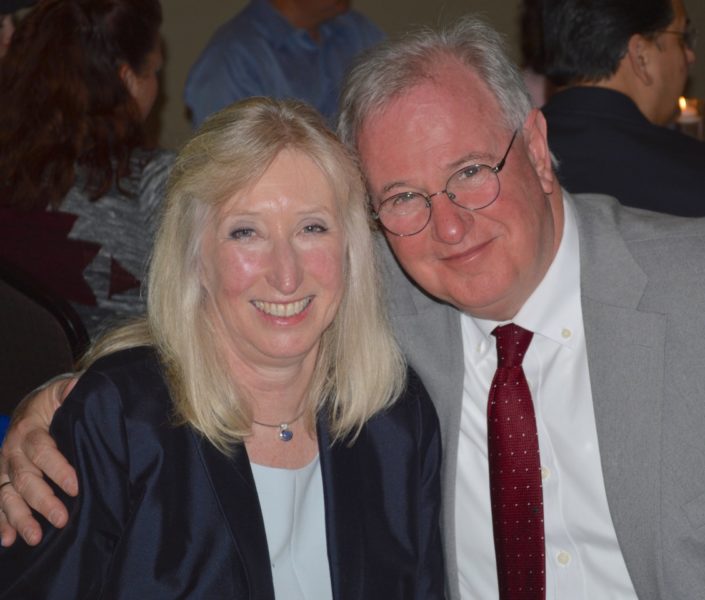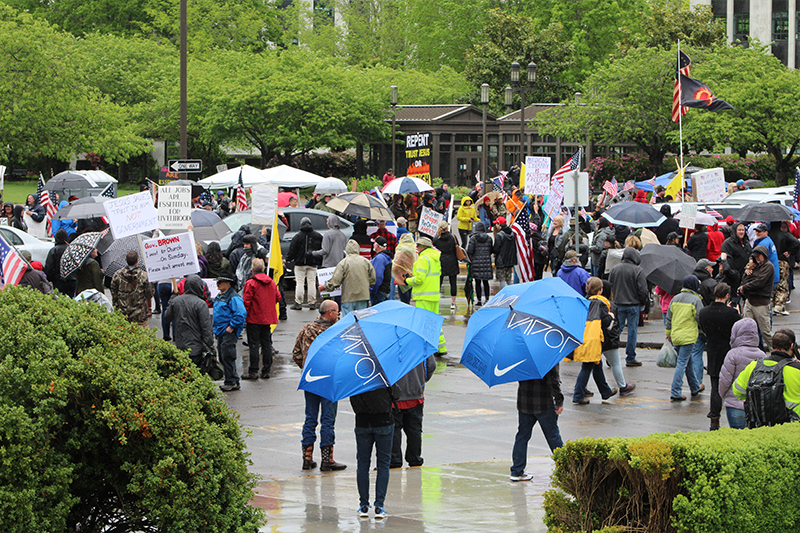Oregon Air National Guard to conduct Air Force Salute flyovers in Oregon
SALEM, Ore. – The Oregon Air National Guard is scheduled to fly multiple F-15 Eagle flyovers over hospitals and other locations throughout Oregon during the month of May in order to salute Oregonians on the forefront of the COVID-19 pandemic and lift morale during a time of severe health and economic impacts.
The tribute is scheduled to be conducted by Oregon’s 173rd Fighter Wing, based in Klamath Falls and the 142nd Wing, based in Portland.
“This is a joint effort to demonstrate support and give thanks to healthcare workers, first responders, and other essential workers on the frontline of the COVID-19 response; the goal is to unite all Oregonians during this time,” said Stephen Bomar, Director of Public Affairs for the Oregon Military Department. “This effort also demonstrates the full capabilities of our Oregon National Guard Citizen Soldiers and Airmen. Whether on the ground delivering needed Personal Protective Equipment throughout Oregon or in the skies protecting the Pacific Northwest, the Guard is in this together with Oregonians.”
Anyone living in and around these hospitals should see and hear the jets. People are encouraged to view the flights from the safety of their own homes and practice physical distancing.
The flyovers are scheduled for the following locations at the approximate designated times Friday, May 8.
Northern Oregon:
8:50 a.m. Peacehealth Southwest Medical Center, Vancouver, Wash.
8:58 a.m. Providence Hood River Memorial Hospital, Hood River, Ore.
9:00 a.m. Oregon Veterans Home, The Dalles, Ore.
9:00 a.m. VA Healthcare System the Dalles CBOC, The Dalles, Ore.
9:01 a.m. Mid-Columbia Medical Center, The Dalles, Ore.
9:11 a.m. Legacy Mount Hood Medical Center, Gresham, Ore.
9:12 a.m. Vibra Specialty Hospital of Portland, Portland, Ore.
9:12 a.m. Adventist Medical Center, Portland, Ore.
9:13 a.m. Kaiser Permanente Sunnyside Medical Center, Clackamas, Ore.
9:13 a.m. Providence Willamette Falls Medical Center, Oregon City, Ore.
9:15 a.m. Providence Milwaukie Hospital, Milwaukie, Ore.
9:15 a.m. OHSU Towers (Over Willamette River), Portland, Ore.
9:16 a.m. Providence Portland Medical Center, Portland, Ore.
9:16 a.m. Legacy Emanuel Medical Center, Portland, Ore.
9:17 a.m. Legacy Good Samaritan Medical Center, Portland, Ore.
9:17 a.m. OHSU Hospital, Portland, Ore.
9:17 a.m. Shriners Hospitals for Children, Portland, Ore.
9:17 a.m. VA Portland Healthcare System, Portland, Ore.
9:18 a.m. Legacy Meridian Park Medical Center, Tualatin, Ore.
9:19 a.m. Providence St. Vincent Medical Center, Portland, Ore.
9:20 a.m. Kaiser Permanente Westside Medical Center, Hillsboro, Ore.
9:21 a.m. Tuality Community Hospital, Hillsboro, Ore.
9:28 a.m. Coastal Family Health Center, Astoria, Ore.
9:30 a.m. Providence Seaside Hospital, Seaside, Ore.
9:36 a.m. Adventist Medical Center, Tillamook, Ore.
9:46 a.m. Samaritan Pacific Communities Hospital, Newport, Ore.
9:52 a.m. Good Samaritan Regional Medical Center, Corvallis, Ore.
9:54 a.m. Samaritan Albany General Hospital, Albany, Ore.
9:56 a.m. Oregon Veteran’s Home, Lebanon, Ore.
9:56 a.m. Samaritan Lebanon Community Hospital, Lebanon, Ore.
9:59 a.m. Santiam Hospital, Stayton, Ore.
10:04 a.m. Salem West Valley Hospital, Dallas, Ore.
10:07 a.m. Salem Health Hospital, Salem, Ore.
10:08 a.m. Department of Public Safety, Standards, and Training, Salem, Ore.
10:10 a.m. Oregon Office of Emergency Management, Salem, Ore.
10:10 a.m. Oregon State Capitol, Salem, Ore.
10:13 a.m. Legacy Silverton Hospital, Silverton Ore.
10:17 a.m. Willamette Valley Medical Center, McMinnville, Ore.
10:20 a.m. Providence Hospital, Newberg, Ore.
Southern Oregon:
10:10 a.m. Lake District Hospital, Lakeview, Ore.
10:25 a.m. Harney District Hospital, Burns, Ore.
10:40 a.m. Saint Alphonsus Medical Center, Ontario, Ore.
11:10 a.m. Saint Charles Prineville, Prineville, Ore.
11:15 a.m. Saint Charles Redmond, Redmond, Ore.
11:20 a.m. Saint Charles Bend, Bend, Ore.
“We are honored to pay tribute to everyone who has served on the frontlines during this pandemic,” said Brig. General Donna Prigmore, Commander of the Oregon Air National Guard. “This is a small way of showing our gratitude for the big sacrifices that our healthcare workers, emergency responders, and so many others have made. We thank all of you.”
All flyover plans have been coordinated as a part of OPERATION: AMERICAN RESOLVE to salute those at the forefront of the COVID-19 response and will be done in conjunction with regularly scheduled training. Pilots must perform a minimum number of flight hours to maintain proficiency. These flyovers will incur no additional cost to taxpayers and are done in lieu of regularly scheduled training.
Additional Oregon Air National Guard flyovers are scheduled to continue next Friday, May 15.
The Air Force Salutes flyover plan also includes flyovers from the United States Air Force Thunderbirds demonstration team, which are scheduled to fly over the Pacific Northwest in late May.
All passes are approximately 1,500 feet above ground level at approximately 400 mph airspeed. Flights could be canceled or times changed due to inclement weather or operational contingencies.
Anyone who gets video or photos of the F-15s flying overhead are encouraged to post on social media using the hashtags: #AirForceSalutes, #AFFlyover, #FlyoverFriday, #Inthistogether
The Oregon Air National Guard has been an integral part of the nation’s air defense since 1941. Pilots from the 173rd Fighter Wing and the 142nd Wing train for a variety of mission skill sets in order to maintain combat readiness for the defense of our state and nation. Additionally, the 142nd Wing provides around-the-clock Aerospace Control Alert for the defense of our homeland, while the 173rd FW is home to the sole F-15C pilot training facility for the United States Air Force. Both units also respond to state and national emergencies as directed by the Governor of Oregon.







































